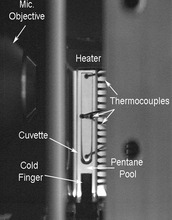All Images
Learning from fluids, in space

Michel Louge, Olivier Desjardins and students at Cornell University are studying inbibition, the process of a colloid or solid absorbing water. The idea is to create relatively large spheres of water in microgravity to highlight the onset of liquid absorption into porous media. Such initial behavior determines how much water get absorbed and how fast. Imbibition is important to many applications that involve the wetting of porous surfaces, including fuel cells, irrigation and the manufacture of pharmaceuticals.
They performed initial experiments with spheres of water and porous material in a container that reached microgravity conditions for less than a second when dropped from great height at Cornell. They will send similar experiments into space, where the gravity-free environment will allow them to study the phenomenon for a longer time and with greater resolution.
Credit: Carlos Mejia, Doug Berman, John Bartlett and Richard Goodwyn, Cornell University
Download the high-resolution GIF version of the image. (1.2 MB)
Use your mouse to right-click (Mac users may need to Ctrl-click) the link above and choose the option that will save the file or target to your computer.

Researchers Paolo Luzzatto-Fegiz and Eckart Meiburg of the University of California, Santa Barbara, will study forces between small particles that tend to cluster, specifically quartz and clay sediment particles.
The advantage of conducting experiments at the International Space Station (ISS) is that it will be possible to separate the forces acting on the particles among short range (adhesive forces) and long range (cohesive forces), since one can observe the clustering dynamics over very long time scales without gravitational settling, which complicates the measurements when doing experiments on Earth.
The quartz-clay system is common in a wide variety of environments (rivers, lakes, oceans) and plays an important role in technological efforts related to deep sea hydrocarbon drilling and CO2 sequestration.
The image above shows examples of sediment transport typical of continental margins and deep lakes. In the high-resolution version available below, the right side shows a close-up view of the interaction between fluid motion and sediment particles, from a computer simulation.
Credit: Eckart Meiburg, University of California, Santa Barbara
Download the high-resolution JPG version of the image. (1.1 MB)
Use your mouse to right-click (Mac users may need to Ctrl-click) the link above and choose the option that will save the file or target to your computer.

Heat pipes are commonly used to manage heat. A special design of an experimental heat pipe, with transparent walls and many thermocouples, will enable researchers to study what's happening inside, where fluid undergoes changes of phase between liquid and vapor. The motion of the liquid and vapor inside, and the motion and dynamics of the interface between the two phases, can strongly affect the performance of heat pipes and similar systems.
With the help of astronauts, Joel Plawsky of Rensselaer Polytechnic Institute will use this equipment to study phenomena at the liquid-vapor boundary for mixtures of fluids that promise better heat transfer performance. His project may have implications for energy conversion, distillation, electronics and other technologies.
Credit: Joel Plawsky, Rensselaer Polytechnic Institute
Download the high-resolution PNG version of the image. (400.1 KB)
Use your mouse to right-click (Mac users may need to Ctrl-click) the link above and choose the option that will save the file or target to your computer.

A growing number of advanced materials are manufactured by assembling colloidal particles. The assembly can be controlled by applying external fields that affect the motion and arrangement of the particles, which has implications for the material's mechanical properties.
A project led by Eric Furst of the University of Delaware will study the assembly of magnetic particles in the presence of a toggled magnetic field while in space.
The microgravity environment of the International Space Station is important for these experiments, because gravity would make the particles sediment at an increasing rate as they form large and complicated structures.
Credit: Eric Furst, University of Delaware
Download the high-resolution JPG version of the image. (44.5 KB)
Use your mouse to right-click (Mac users may need to Ctrl-click) the link above and choose the option that will save the file or target to your computer.

Inertial spreading is the high-speed flow of a liquid across a supporting surface. Inertial spreading occurs in silicon chip fabrication, 3D additive manufacturing and other industrial and natural settings on Earth. Predictions of inertial spreading are notoriously difficult because of the presence of an advancing or receding line of contact between liquid, solid and surrounding gas, called a moving contact-line.
To enable better prediction and control of inertial spreading, Paul Steen and Susan Daniel of Cornell University will investigate fundamental aspects of the phenomenon and develop a theory to predict drop oscillation modes and the mobilization of droplets. Understanding contact line ‘mobility’ can help characterize the contact-line behavior during inertial spreading. Contact-line mobility measurement on Earth is challenging, however, because of sticking and slipping that occurs at small scales and that happens fast. The reduced gravity of the International Space Station (ISS) makes the corresponding behavior larger and slower and therefore possible to measure.
In the image above, a vibrating droplet, next to a solid, stationary block, is driven at resonance, an observation by which the mobility can be measured. Note the considerable motion of the contact-line.
Credit: Paul H. Steen and Yi Xia, Cornell University
Download the high-resolution GIF version of the image. (3.3 MB)
Use your mouse to right-click (Mac users may need to Ctrl-click) the link above and choose the option that will save the file or target to your computer.


